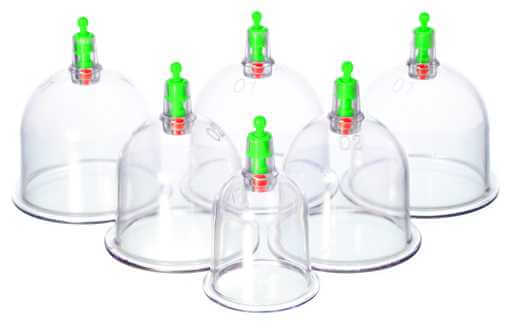Cupping
Cupping Therapy
Cupping is a technique used to relieve tight muscles and tissue congestion. Rather than compressing down into the tissue, cups reverse compress. The superficial tissue is slightly raised, which creates space.
This movement allows fresh oxygenated blood to move into the space. This will give muscles and other tissue the means necessary to begin to lengthen and revert back to their anatomical position.

Lymph congestion is normal when muscles are tight or not moving correctly. Lymph moves only when muscles contract. The lymphatic system does not have a pump system, like a heart with blood. Rather, lymph relies on muscle movement. The cups allow the muscles to receive the much needed fresh oxygenated blood to regain balance and movement. Once the muscles are moving correctly, the lymph can once again be on the move either to lymph nodes or recycled back into the blood stream.
The marks remaining after a cupping session should not be confused with bruises. It is simply the signs of lymph stagnation. These marks will disappear within a few days. Lots of water will help speed the process.
Frequently Asked Questions
Included below are answers to some of my clients’ most frequently asked questions. Give me a call or use my contact form to reach out if the answer to your question is not found here. I’m available to help!
What is the purpose of Cupping?
Modern Cupping is a descent of ancient Chinese methods of relieving pain. In order to understand cupping, you first need to understand the function of lymph in the body. Our body produces fluid called lymph. Lymph is a clear fluid which is everywhere in our body. It cushions organs, allows muscles and other tissue to glide over each smoothly, and perhaps most importantly, it carries white blood cells to areas of trauma. The lymph system does not include a pump system (i.e. heart) to move the lymph around the body.
Lymph travels via muscle contraction and gravity. If you are experiencing muscle tightness, the lymph stays stagnate in that particular area. It cannot navigate without the proper function of the muscle. This is where cupping comes in! Placing cups in an area of muscle tightness, we can create space between muscles and tissue. This space is created when the tissue is suctioned up into the cup. Once space is created, fresh, oxygenated blood can rush into the space to help muscle recovery and bring in fresh lymph.
Why do I have marks after cupping?
When the tissue is suctioned up into the cups allowing fresh, oxygenated blood to rush in, the stagnated lymph needs to go somewhere. It is pulled superficially towards the surface layer of the skin, resulting in circular or oval colored shapes.
Are the cupping marks bruises?
No, properly placed cups do not bruise the skin. Bruises indicate trauma to the skin which is the opposite of the technique of cupping. Some cupping marks will be darker than others. The darker the marks, the more stagnation the lymph was in the area. They should disappear in 24 hours to perhaps up to 4 days, depending on the level of stagnation of the lymph. Plenty of extra water will help those marks disappear quicker.
Does cupping hurt?
I’ve asked all my new cupping patients what it feels like to have cupping done. Most say it’s hard to describe but definitely doesn’t hurt. It’s more of a pinching feeling when the cups are first applied to the skin. Once the cups have been placed it takes 30-60 seconds for the tissue in the cups to become numb. Then there is no feeling produced by the cups.
*By booking an appointment you are agreeing to adhere to my policies.
